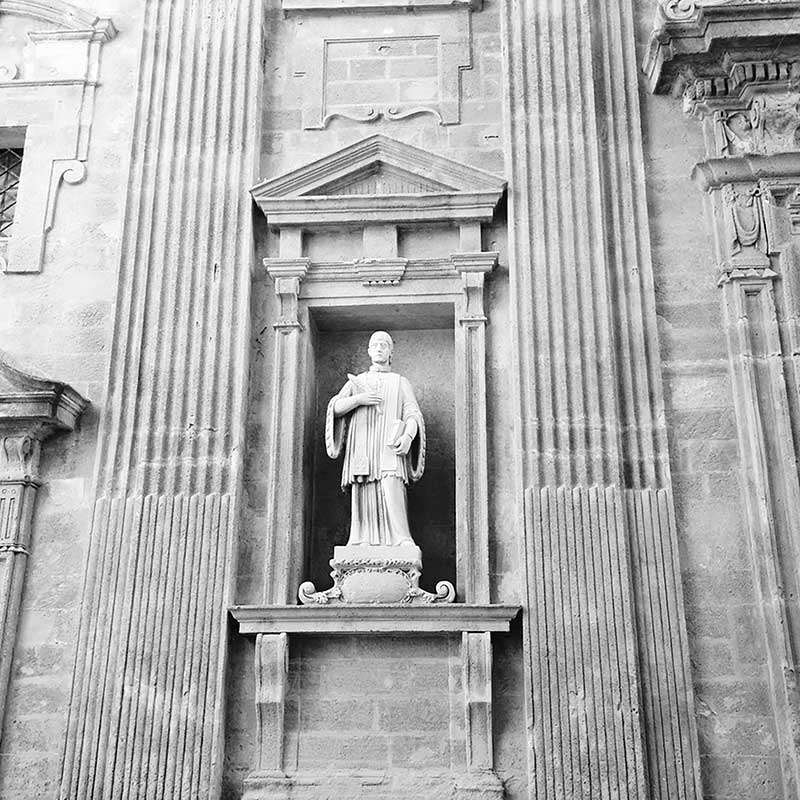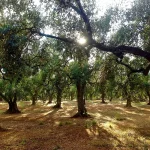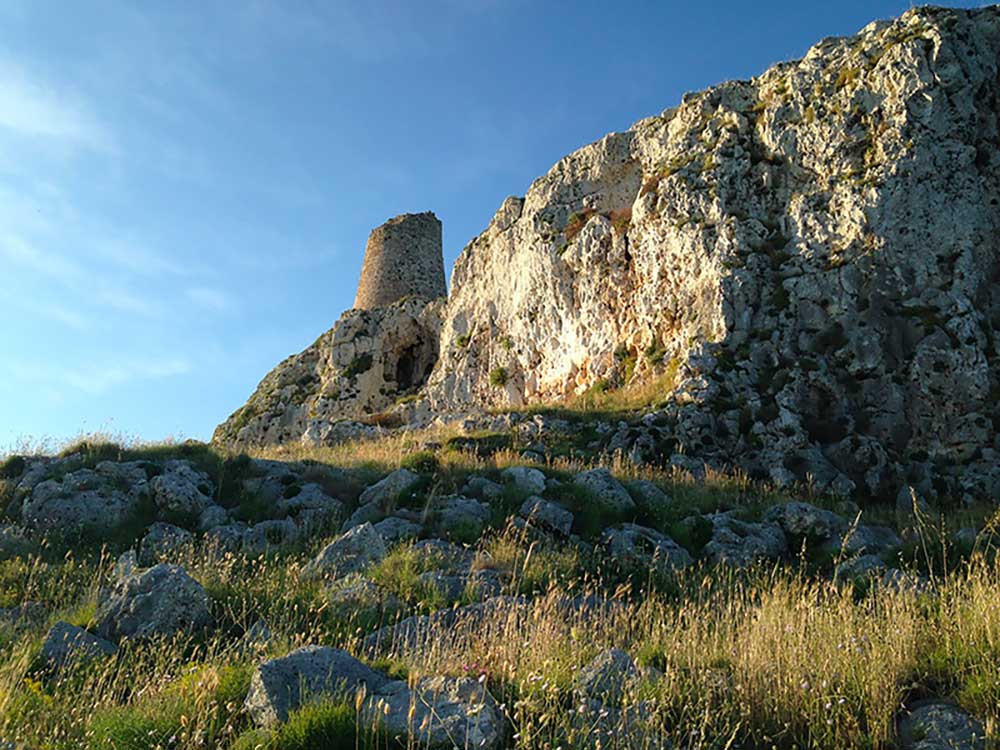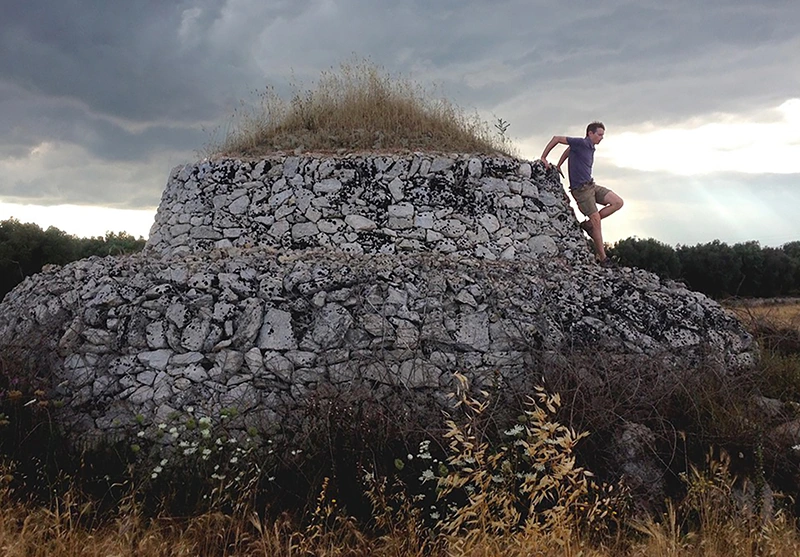Rudston Steward is the adventurist founder of Maremma Safari Club, guided walking trips to unexplored corners of Italy for curious travellers.
A three-day walking tour in Puglia
Few things are more cartographically tempting than an isthmus: a narrow strip of land with the sea on either side. Whenever I map-read my gaze is inevitably drawn to such land bridges, wondering how best they might be crossed on foot; the idea of hiking coast-to-coast linking up two seas is, to me, irresistible. Every isthmus is a walking safari just waiting to happen—which is why I recently walked across Puglia: three days from Gallipoli on the Ionian Sea coast-to-coast to Otranto on the Adriatic. Here are some field notes:
Day 1
Morning
Puglia’s southern Ionian coast turns out to be a very strange place, a scrappy landscape dotted with architectural oddities and eccentric individuals. Leaving Gallipoli the contrast between the charm of the old city center, with its warren of narrow lanes and soaring Baroque cathedral, and the urban mess that surrounds it, is a bit jarring. I head onto a bridge, over the highway, through a fence and diagonally across a field into farmland; gradually the Ionian sprawl subsides in my wake.

Lunch-time
Blisteringly hot. Picnic and long siesta in the shade of an olive grove, just outside the town of Matino.
Afternoon
The last two hours of the walk are completely flat, straight narrow roads through grasslands, beige fields and crumbling stone walls. The olive groves have been scorched by the Xylella Fastidiosa disease plaguing southern Puglia, an insect-borne bacteria decimating the region’s olive groves.
Evening
My Agriturismo for the night is laid out on the flank of a low hill. Beyond, stretching eastwards, the landscape changes: greener, lusher, the olives groves better-kept. Tomorrow I will walk into the olive-green heart of the Puglian interior.

Day 2
Morning
Today’s trail weaves in and out of a succession of seemingly endless olive groves—for eleven hours and 30km. Olives occupy every inch of land separating one town from the next: Scorrano, Sanarica, Giuggianello, Giurdignano. Urban centres strung out in a ragged line across the Salento interior: off-white isles of stone and stucco floating in a vast sea of dappled olive-green. There are about 60 million olive trees in Puglia; the region is Italy’s largest olive oil producer by far, accounting for about 40% of the national output. The local Ogliarola olive trees are large, some fifteen meters high, yielding a fruity, lime-golden oil, bittersweet and fragrant as an almond blossom.
Lunch-time
he sun reaches its caustic apex, intent on melting the rest of the afternoon into an impressionistic haze. Another siesta is very much called for.
Afternoon
Just before Giurdignano I pass a megalithic standing stone, rectangular and 2.5 meters high, called the Menhir of Saint Paul. Below the menhir there’s a small Byzantine crypt dedicated to Paul, the saint associated with tarantism. It was popularly believed that the bite of the local wolf spider (Lycosa Tarantula) caused a hysterical condition that could be cured only by long stints of frenzied dancing. Thus, the theory goes, the musical form of the Tarantella was born: in essence, a frenetic and curative musical exorcism.
Day 3
Morning
I can smell the sea: Giurdignano is only 6km from the coast at Otranto.
Lunch-time
Otranto. It’s easy to get carried away by symbolism and history around here; the mosaic pavement of Otranto’s cathedral is one of the great symbolic artworks of medieval Italy, a product of the singular historic era of Norman rule. The composition, laid out by a monk called Pantaleone between 1163 and 1165, covers the entire floor plan, and is based on a “Tree of Life” whose trunk rests on the backs of two elephants. There are twelve circles depicting the astrological signs and agricultural tasks of each month, a mermaid-dragon, a fantastical reindeer, heaven and hell, assorted mythological beasts and scenes from the scriptures, Alexander the Great, and the Kings Solomon and Arthur.
Afternoon
I arrive at the beach, unload my backpack. Walk into the waves. Make my symbolic offering to the Adriatic Sea—having walked all the way from the Ionian. The water is of an uncanny temperature, it makes my flesh tingle and my mind buzz.

Evening
Later I walk on from Otranto to Porto Badisco, via the lighthouse of Punta Palascìa and Capo d’Otranto. This is the easternmost point of Italy: Land’s Eastern End. Across the sea the granite-grey peaks of the Ceraunian Mountains in Albania glimmer faintly. Further south, the Greek Island of Othoni is a smudge of purple shadow above the sea’s blue sheen.

Epilogue
Capo d’Otranto marks the point, cartographically speaking, where the southern Adriatic and northern Ionian Seas meet. My Puglian Safari thus came full circle: from the Ionian Sea at Gallipoli, to the Adriatic Sea at Otranto, and back to the Ionian at Porto Badisco. On foot across Puglia: coast-to-coast-to-coast.
